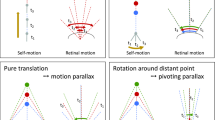Summary
When approaching a landing site flies (Musca domestica) extend their legs in order to prevent crash-landing. Pattern expansion in front of a tethered fly can mimic an approach towards a landing site. Under these conditions landing is a rather stereotyped motor pattern. Only the latency of the onset of the landing response varies with the stimulus strength. Quantitative studies of the stimulus-latency relationship led to the formulation of a simple model which describes the way movement information at the fly's retina is processed in order to trigger landing. We propose that the output of local directionally selective movement detectors are spatially pooled and subsequently integrated in time. Whenever the level of this integrated signal reaches a fixed threshold landing is released.
Similar content being viewed by others
References
Borst A (1986) Time course of the houseflies' landing response. Biol Cybern 54:379–383
Borst A, Bahde S (1986) What kind of movement detector is triggering the landing response of the housefly? Biol Cybern 55:59–69
Borst A, Bahde S (1987) Comparison between the movement detection systems underlying the optomotor and the landing response in the housefly. Biol Cybern 56:217–224
Borst A, Egelhaaf M (1987) Temporal modulation of luminance adapts time constant of fly movement detectors. Biol Cybern 56:209–215
Borst A, Bahde S (in press) Spatio-temporal integration of motion: a simple strategy for safe landing in flies. Naturwissenschaften
Braitenberg V, Taddei Ferretti C (1966) Landing reaction ofMusca domestica induced by visual stimuli. Naturwissenschaften 53:155–156
Buchner E (1976) Elementary movement detectors in an insect visual system. Biol Cybern 24:85–101
Eckert H (1980) Orientation sensitivity of the visual movement detection system activating the landing response of the blowflies,Calliphora andPhaenicia: a behavioral investigation. Biol Cybern 37:235–247
Eckert H, Hamdorf K (1980) Excitatory and inhibitory response components in the landing response of the blowfly,Calliphora erythrocephala. J Comp Physiol 138:253–264
Eckert H, Hamdorf K (1981) The contrast frequency-dependence: a criterion for judging the non-participation of neurons in the control of behavioural responses. J Comp Physiol 145:241–247
Eckert H, Hamdorf K (1983) Does a homogeneous population of elementary movement detectors activate the landing response of blowflies,Calliphora erythrocephala? Biol Cybern 48:11–18
Egelhaaf M (1985) On the neuronal basis of figure-ground discriminiation by relative motion in the visual systems of the fly. I. Behavioral constraints imposed on the neuronal network and the role of the optomotor system. Biol Cybern 52:123–140
Egelhaaf M, Reichardt W (1987) Dynamic response properties of movement detectors: theoretical analysis and electrophysiological investigation in the visual system of the fly. Biol Cybern 56:69–87
Ejima Y (1987) Simple reaction time to sinusoidal grating and perceptual integration time: contributions of perceptual and response processes. Vision Res 27:269–276
Fischbach KF (1981) Habituation and sensitization of the landing response ofDrosophila melanogaster. Naturwissenschaften 68:332
Goodman LJ (1960) The landing responses of insects I. The landing response of the fly,Lucilia sericata, and other Calliphorinae. J Exp Biol 37:854–878
Hassenstein B, Reichardt W (1956) Systemtheoretische Analyse der Zeit-, Reihenfolgen- und Vorzeichenauswertung bei der Bewegungsperzeption des RüsselkäfersChlorophanus. Z Naturforsch 11b: 513–524
Hausen K (1984) The lobula complex of the fly: structure, function and significance in visual behavior. In: Ali MA (ed) Photoreception and vision in invertebrates. Plenum Press, New York London, pp 523–559
Miles FA, Kuwano K (1986) Short-latency ocular follwing responses of monkey. I. Dependence on temporospatial properties of the visual input. J Neurophysiol 56:1321–1354
Reichardt W (1961) Autocorrelation, a principle for the evaluation of sensory information by the central nervous system. In: Rosenblith WA (ed) Sensory communication. MIT Press Wiley, New York London, pp 303–317
Reichardt W (1987) Evalution of optical motion information by movement detectors. J Comp Physiol A 161:533–547
Reichardt W, Poggio T, Hausen K (1983) Figure-ground discrimination by relative movement in the visual system of the fly. II. Towards the neural circuitry. Biol Cybern 46 [Suppl]:1–30
Ruyter van Steveninck RR de, Zaagman WH, Mastebroek HAK (1986) Adaptation of transient responses of a movement-sensitive neuron in the visual system of the blowflyCalliphora erythrocephala. Biol Cybern 53:451–463
Wehrhahn C, Hausen K, Zanker J (1981) Is the landing response of the housefly driven by motion of a flowfield? Biol Cybern 41:91–99
Williams JM, Lit A (1983) Luminance-dependent visual latency for the Hess effect, the Pulfrich effect, and simple reaction time. Vision Res 23:171–179
Author information
Authors and Affiliations
Rights and permissions
About this article
Cite this article
Borst, A., Bahde, S. Visual information processing in the fly's landing system. J. Comp. Physiol. 163, 167–173 (1988). https://doi.org/10.1007/BF00612426
Accepted:
Issue Date:
DOI: https://doi.org/10.1007/BF00612426




